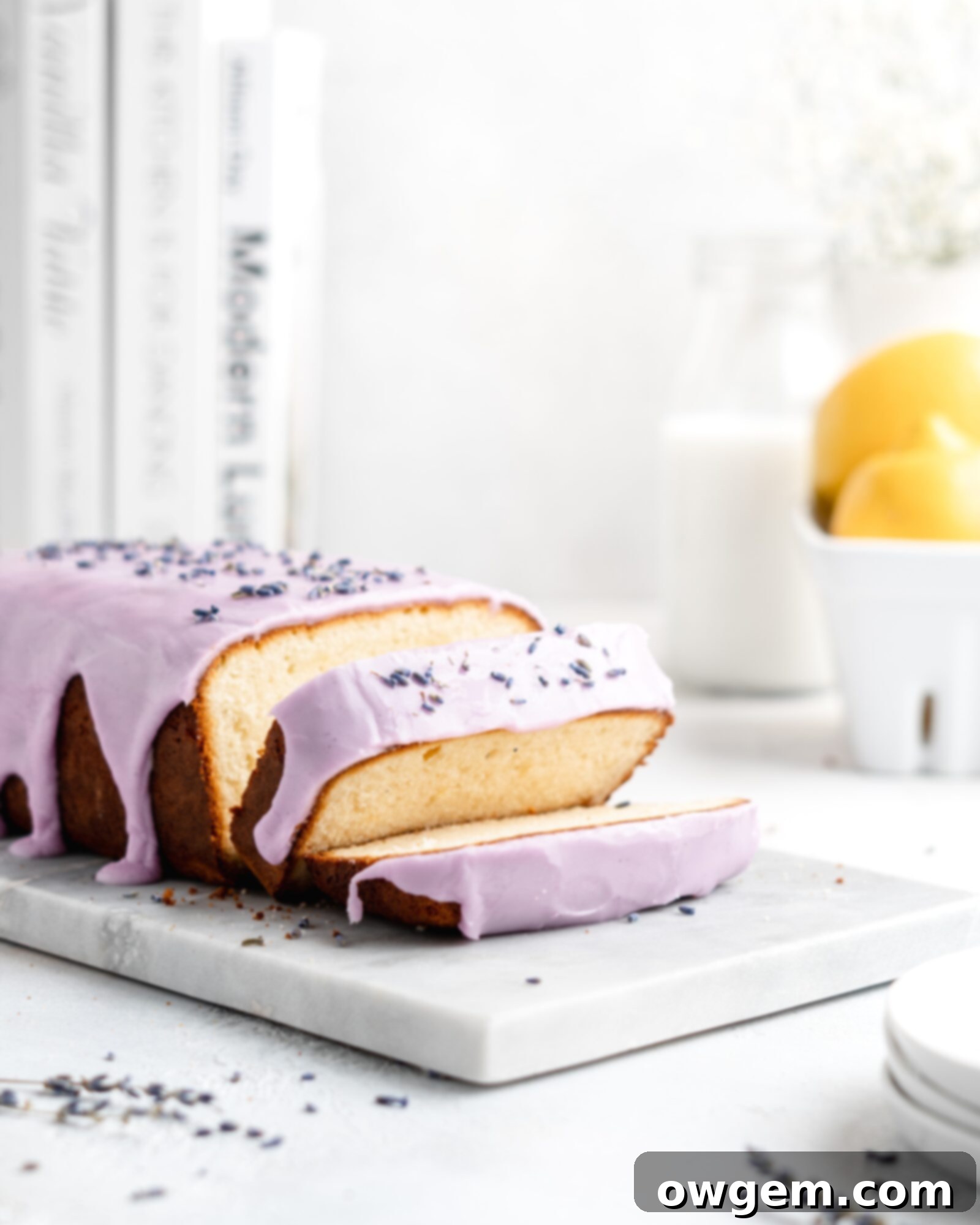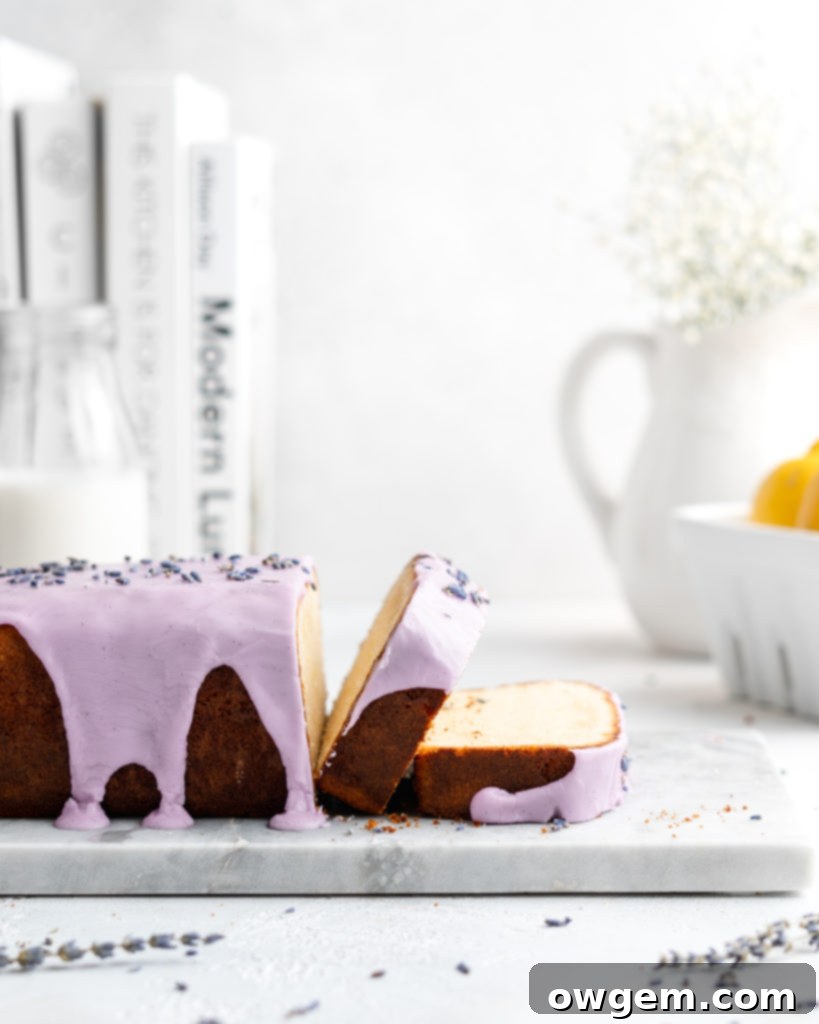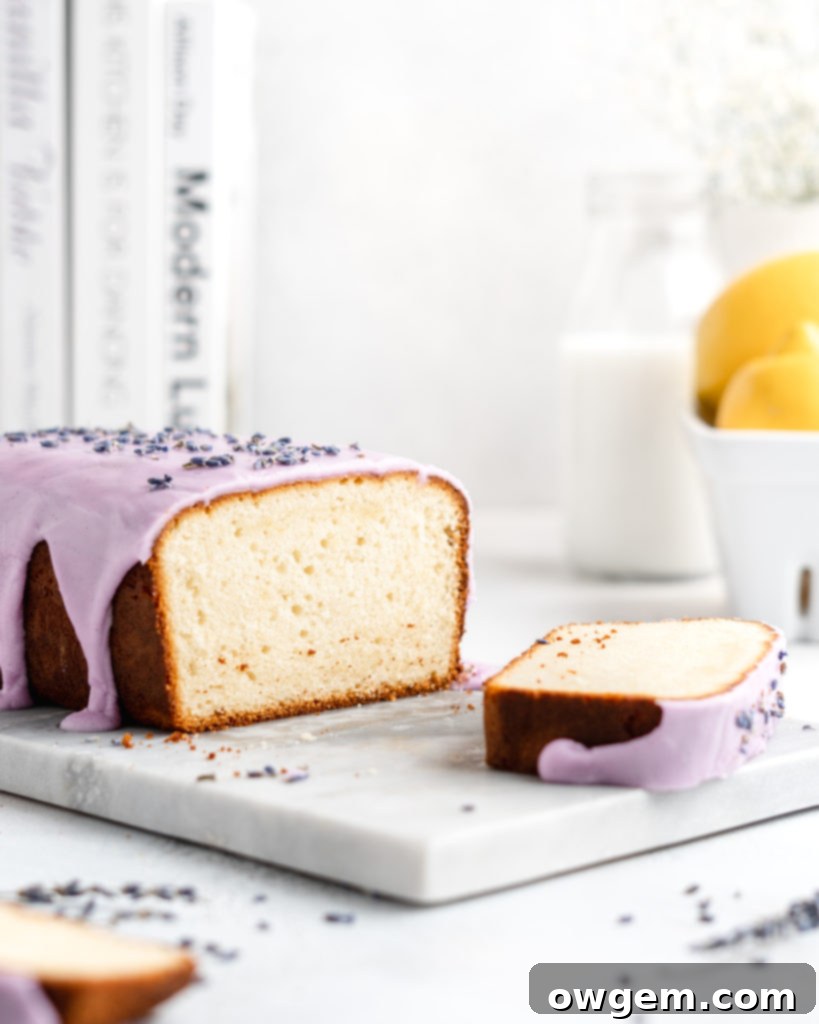Bright & Aromatic: The Ultimate Lemon Lavender Loaf Cake Recipe for Spring
Imagine a dessert that captures the essence of a vibrant spring garden – that’s exactly what you get with this exquisite Lemon Lavender Loaf Cake. Bursting with the bright, zesty notes of fresh lemon and complemented by the delicate, enchanting aroma of culinary lavender, this loaf cake is a true sensory delight. It’s more than just a cake; it’s an experience, transforming your kitchen into a haven of sweet, floral, and citrusy fragrances. Perfect for afternoon tea, a celebratory brunch, or simply as a comforting treat, this easy-to-make Lemon Lavender Loaf Cake promises a light, fluffy texture and a perfectly balanced flavor profile that will leave a lasting impression.
Our unique approach to this classic combination ensures maximum flavor extraction from every ingredient. We don’t just add lemon zest and lavender; we unlock their full potential. Freshly zested lemon is lovingly rubbed with sugar, a simple yet powerful technique that releases the concentrated essential oils, intensifying that irresistible lemony kick. The vibrant juice of freshly squeezed lemons adds a tangy counterpoint, ensuring the cake is moist and flavorful throughout. But the true secret to its unparalleled floral depth lies in “blooming” the dried culinary lavender in oil, a method designed to draw out all those complex, aromatic compounds that water simply can’t. The result? A light and fluffy loaf cake with an ethereal lightness, where subtle floral overtones dance harmoniously with the bright, cheerful citrus.
This recipe isn’t just about following steps; it’s about understanding the nuances that elevate a good cake to a truly unforgettable one. From selecting the right type of lavender to mastering the art of flavor extraction, every detail has been considered to ensure your baking success. Prepare to impress your family and friends with a dessert that looks as beautiful as it tastes, featuring a moist crumb and a fragrant glaze that beckons you for just one more slice. Let’s dive into the world of delicate flavors and discover how to create this magnificent spring-time masterpiece.
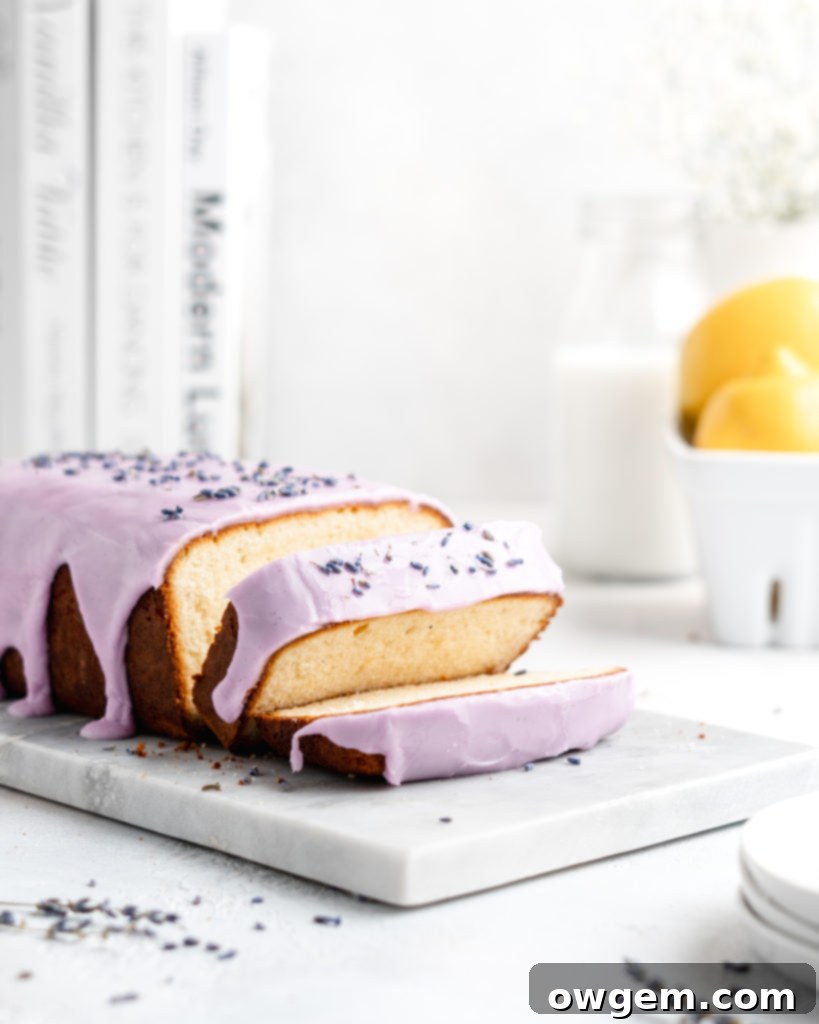
Culinary Lavender vs. Regular Lavender: Why Ingredient Quality Matters
When embarking on any baking adventure that includes lavender, especially for a delicate recipe like this Lemon Lavender Loaf Cake, the distinction between culinary grade lavender and its ornamental counterparts is absolutely paramount. It’s not merely a suggestion; it’s a critical factor for both safety and achieving the intended delicate flavor.
Firstly, and most importantly, culinary grade lavender is the only safe lavender to consume. This isn’t just about taste; it’s about health and peace of mind. Culinary lavender is specifically cultivated, harvested, and processed in environments that meet food-grade standards. This means it has been grown without harmful pesticides, herbicides, or other chemicals that are commonly used on non-culinary varieties intended solely for decorative purposes or aromatherapy. Regular garden lavender, while beautiful and fragrant, may have been treated with substances not intended for human ingestion. Always ensure your lavender source explicitly states “culinary grade” or “food grade” to guarantee its safety for baking and to avoid any potential health risks or unpleasant chemical tastes.
Secondly, culinary lavenders are specifically chosen for their superior flavor and aroma profiles. There are numerous varieties of lavender, but culinary types, such as Lavandula angustifolia (often referred to as English Lavender), are prized for their sweeter, more nuanced, and less camphorous notes. Non-culinary lavenders, like some varieties of Lavandula stoechas (Spanish Lavender) or Lavandula x intermedia (Lavandin), often possess a stronger, more medicinal, or pine-like scent and taste that can be overpowering and frankly unappetizing in baked goods. English lavender, in particular, offers a delicate floral sweetness that beautifully complements citrus flavors without tasting like soap or perfume. Selecting the right variety ensures your Lemon Lavender Loaf Cake achieves that perfect balance of floral elegance rather than an overwhelming botanical presence. Look for dried buds and flowers that are vibrant in color and intensely fragrant upon gentle crushing.
Understanding this distinction is key to achieving the sublime flavor balance in your Lemon Lavender Loaf Cake. Always choose reputable sources for your culinary lavender, ensuring it’s organic and specifically labeled for consumption. This small detail makes a world of difference in the final taste and enjoyment of your baked goods, elevating your cake from good to truly exceptional.
Blooming the Lavender in Oil: Unlocking Deep Floral Flavor
One of the most crucial techniques that sets this Lemon Lavender Loaf Cake apart and contributes significantly to its unique flavor profile is the method of “blooming” the lavender in oil. While many recipes might suggest steeping lavender in hot water or milk, our approach leverages a fundamental scientific principle: lavender’s primary flavor compounds are largely fat-soluble. This means that its delicate and complex aromatic compounds are much more efficiently extracted and released by oil or fat than by water, which primarily extracts different compounds.
When you steep lavender in hot water, you often extract water-soluble compounds that can impart more bitter, herbaceous, or “perfumey” notes, sometimes leading to a less desirable flavor in your baked goods. However, by gently warming the lavender in oil, you’re directly dissolving and extracting the essential oils that contain the plant’s true sweet, subtle, and integrated floral essence. This “blooming” process in hot oil results in an exceptionally more flavorful and multi-dimensional taste from the lavender. It gives this Lemon Lavender Loaf Cake an extraordinary depth and “oomph” that traditional methods simply can’t achieve, ensuring the lavender notes are harmonious and delightful, not overpowering or artificial.
The process itself is surprisingly simple, yet incredibly effective. You’ll begin by heating a neutral-flavored oil, such as canola or vegetable oil, over medium-high heat for approximately one minute. The goal is to warm the oil, allowing it to become a solvent for the lavender’s essential oils, but not to make it scorching hot or smoke. Once adequately warmed, remove the saucepan from the heat and immediately stir in the dried culinary lavender. The residual heat from the oil will gently coax out those precious essential oils. Cover the pot with a lid to trap the aromatic vapors and allow the lavender to infuse, or ‘bloom,’ for 30 minutes to an hour. This extended steeping time allows the oil to fully absorb the lavender’s fragrant essence, creating a potent and aromatic infusion. After this infusion period, simply strain the lavender out of the oil using a fine-mesh sieve, leaving behind a beautifully scented, lavender-infused oil ready to elevate your loaf cake. This simple yet profound step is a game-changer, promising a truly aromatic and delightfully balanced baking experience.
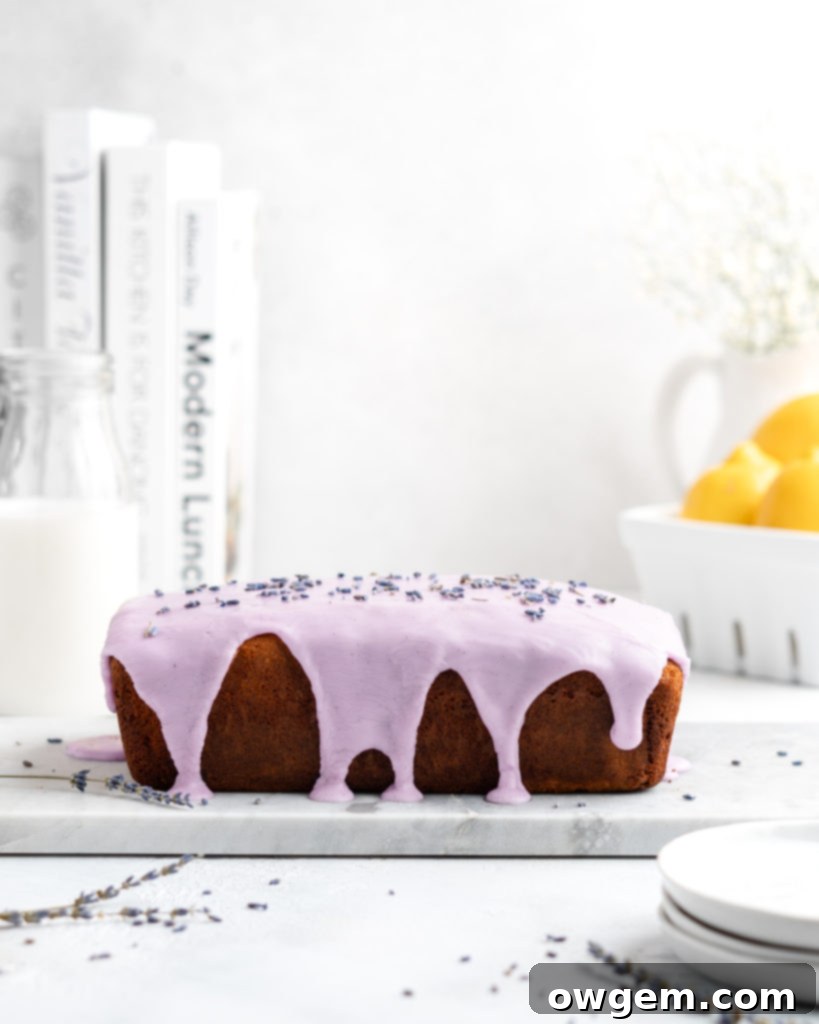
The Art of Rubbing Lemon Zest with Sugar: Maximizing Citrus Aroma
Another essential technique in crafting this incredibly flavorful Lemon Lavender Loaf Cake is the often-overlooked yet remarkably effective step of rubbing lemon zest with sugar. You might initially wonder about the significance of this seemingly small detail, but it is a powerful method for maximizing the lemon flavor and fragrance that will infuse your cake.
The vibrant, aromatic essence of any citrus zest resides primarily in its essential oils, which are stored in tiny, delicate pockets just beneath the fruit’s colorful outer layer. While simply adding zest to a batter will release some flavor, rubbing it with sugar takes this flavor extraction to an entirely new level. The granulated texture of sugar acts as a gentle yet effective abrasive. As you rub the zest with the sugar between your fingertips, these tiny sugar crystals work to physically break open those essential oil pockets, releasing a much more potent burst of lemony aroma and concentrated flavor. It’s a hands-on process that mechanically extracts the fragrant oils, intensifying their presence and ensuring a truly bright and pronounced citrus note in the final product.
This technique isn’t just about mechanical extraction; it also plays a crucial role in distributing the lemon flavor more evenly throughout the sugar. When this intensely flavored sugar is later incorporated into the batter, it melts, ensuring that every bite of your loaf cake is infused with bright, tangy goodness. To perform this step correctly, after zesting your lemons, add the fine zest directly into a bowl with your measured granulated sugar. Using your clean hands or fingertips, gently but firmly rub the zest into the sugar. Continue this rubbing action for 1-2 minutes until you notice a significant transformation: the sugar will begin to turn a pale yellow color, visibly absorbing the oils and pigments from the zest. Simultaneously, the aroma released will become incredibly intense and fragrant, filling your kitchen with a delightful citrus perfume. This clear transformation is your cue that you’ve successfully unlocked the lemon’s full potential, preparing it to infuse your cake with unparalleled brightness and perfectly balancing the delicate lavender notes. This simple, hands-on step elevates the lemon component from merely present to vibrantly prominent.
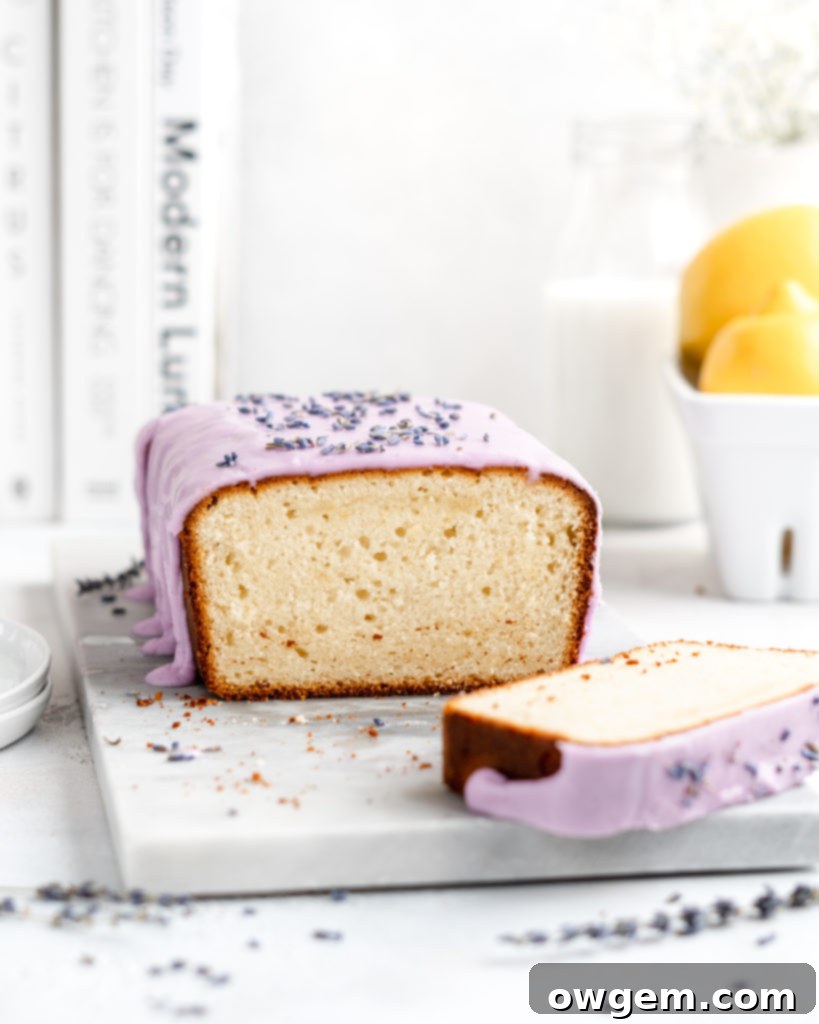
Making the Lemon Lavender Loaf Cake: Step-by-Step Perfection
Crafting this delightful Lemon Lavender Loaf Cake involves a few key steps that, when followed carefully, guarantee a moist, tender, and incredibly flavorful result. Pay close attention to the details of each stage to achieve baking excellence.
1. Bloom Lavender in Oil: The Foundation of Flavor
In a medium saucepan, heat your chosen neutral oil (such as vegetable or canola oil) over medium-high heat for approximately one minute, just until it’s warm but not smoking. Immediately remove the pan from the heat and stir in the culinary lavender. Ensure the lavender is fully submerged in the warm oil. Cover the pot tightly with a lid and let the lavender ‘bloom’ and infuse its flavor into the oil for 30 minutes to 1 hour. This extended steeping time is crucial for extracting the fat-soluble flavor compounds that give lavender its distinct taste. Once infused, strain the lavender out using a fine-mesh sieve, pressing gently on the solids with the back of a spoon to extract every last drop of the precious oil. Discard the spent lavender and set aside the fragrant lavender-infused oil to cool slightly.
2. Prepare Your Pan & Dry Ingredients
Before proceeding with the batter, preheat your oven to 350°F (175°C). Next, prepare a standard 9×5 inch loaf pan. Grease the pan thoroughly with oil or baking spray, then line it with parchment paper, allowing an overhang on the longer sides. This parchment “sling” will make it significantly easier to lift the baked loaf out of the pan once it’s cooled. In a separate medium to large mixing bowl, combine the all-purpose flour, baking powder, and salt. Whisk these dry ingredients together thoroughly for about 30 seconds to ensure they are well combined and evenly distributed throughout the mixture. This step prevents pockets of leavening agent or salt in the final cake, contributing to an even rise and consistent texture.
3. Rub Sugar and Lemon Zest: Unleash the Citrus Aroma
In a separate bowl (your stand mixer bowl is perfect for this if you plan to use it immediately for the next step), add the granulated sugar and the freshly zested lemon. Using your clean fingertips, rub the lemon zest into the sugar. Continue rubbing for 1-2 minutes until the sugar becomes noticeably fragrant and takes on a pale yellow hue from the lemon oils. This crucial action breaks open the essential oil cells in the zest, maximizing its flavor and aroma. The more fragrant and yellow your sugar becomes, the more intense and delicious lemon flavor your cake will have!
4. Beat Eggs, Lemon-Sugar, and Vanilla: Achieve Lightness
To the bowl containing your lemon-zest-sugar mixture, add the eggs and vanilla extract. Using a stand mixer fitted with a paddle attachment (or a robust hand mixer), beat these ingredients together on high speed for approximately 3-4 minutes. You’ll observe a significant transformation: the mixture will become thick, pale yellow, delightfully fluffy, and visibly triple in volume. This aeration process is vital for incorporating air into the batter, which contributes significantly to a light and tender crumb in your finished loaf cake, ensuring it’s not dense.
5. Incorporate Lavender Oil: Smooth Infusion
Once the egg mixture is light and fluffy, reduce the stand mixer speed to medium-low. Slowly and gradually drizzle the cooled, lavender-infused oil into the egg mixture while the mixer continues to beat. Pour it in a steady, thin stream. This slow and controlled addition helps to emulsify the oil into the batter, ensuring a smooth and homogenous mixture without deflating the aerated eggs. After all the oil has been added, continue beating for an additional 30 seconds to fully incorporate it. Remember to scrape down the sides of the bowl as needed to ensure everything is well mixed.
6. Alternate Wet & Dry Ingredients: Maintain a Tender Crumb
With the mixer on the lowest speed, begin adding the dry ingredient mixture to the wet mixture in three alternating additions, starting and ending with the dry. First, add approximately one-third of the whisked dry ingredients and mix only until just combined, being careful not to overmix. Then, add half of the plain yogurt and lemon juice mixture, and mix until just combined. Repeat this process: add another third of the dry ingredients, mix, then the remaining yogurt and lemon juice, mix, and finally the last third of the dry ingredients. Mix only until no streaks of flour remain and the batter is smooth and cohesive. Overmixing at this stage can overdevelop the gluten in the flour, which can lead to a tough and chewy cake rather than a tender one.
7. Bake to Golden Perfection & Cool
Pour the prepared Lemon Lavender Loaf Cake batter evenly into your greased and parchment-lined 9×5-inch loaf pan. Gently tap the pan on the counter a couple of times to release any large air bubbles that might create large holes in your cake. Place the pan into the preheated oven and bake for approximately 1 hour, or until a wooden skewer or toothpick inserted into the center of the cake comes out clean. Baking times can vary depending on your oven, so it’s a good idea to start checking for doneness around 50 minutes. Once baked, remove the loaf cake from the oven and let it cool in the pan on a wire rack for about 10-15 minutes. This allows the cake to set fully and makes it easier to handle. Then, using the parchment paper overhang, carefully lift the cake out of the pan and transfer it directly to the wire rack to cool completely. It is absolutely crucial for the cake to be entirely cool before attempting to apply the glaze; otherwise, the warmth will cause the glaze to melt and run off, resulting in a sticky mess rather than a beautiful, even coating.

Get the Recipe:
Lemon Lavender Loaf Cake
Pin
Rate
Ingredients
Lemon Lavender Loaf Cake
- 3/4 cup Vegetable Oil
- 2 tsp Culinary Lavender
- 2 ½ cups (300g) All Purpose Flour,, measured correctly †
- 1 ½ tsp Baking Powder
- 1/2 tsp Salt
- 1 ½ cup Sugar
- Zest of 2 Lemons
- 3 Eggs
- 1 tsp Vanilla
- 3/4 cup Plain Yogurt,, do not use nonfat
- Juice of 2 Lemons
Vanilla Glaze
- 1 ½ cups Confectioners Sugar
- 1/2 tbsp Vegetable Oil
- 2-4 tbsp Boiling Water,, depending on desires glaze thickness
- 1 tsp Vanilla Extract
- Pinch of Salt
- Purple Food Colouring, (Optional)
Equipment
-
Stand mixer
Instructions
Lemon Lavender Loaf Cake
-
In a medium saucepan over medium-high heat, heat vegetable oil for about 1 minute. Remove from heat and stir in the lavender. Cover with a lid and allow the lavender to ‘bloom’ for 30 minutes to 1 hour. After this time, strain the lavender out of the oil, and reserve the oil.
-
Preheat oven to 350°F, and prepare a 9×5” loaf pan with oil and parchment. In a medium to large sized mixing bowl, add the flour, baking powder, and salt, then whisk together to combine.
-
Add the sugar and lemon zest to a bowl, then rub together the sugar and zest until the sugar is colored lightly yellow and very fragrant.
-
In a stand mixer fitted with paddle attachment, add eggs, lemon zest-sugar, and vanilla. Beat on high for around 3-4 minutes, the mixture should look thick, fluffy, and be tripled in volume. Then, slowly drizzle in the lavender-bloomed oil. After all the oil has been added, beat for an additional minute.
-
On low, add the dry mixture to the stand mixer in 3 additions, alternating with the yogurt and lemon juice in between. Beat only until the batter becomes smooth.
-
Add the batter to the loaf pan, then bake in the oven for around 1 hour, or until a toothpick comes out clean. Allow loaf cake to cool completely before glazing.
Vanilla Glaze
-
Add all the ingredients into a bowl, and whisk well to combine. Pour or pipe over the cooled loaf cake to glaze.
Notes
Tips for the Perfect Glaze
The vanilla glaze is the crowning glory of this Lemon Lavender Loaf Cake, adding both visual appeal and an extra layer of sweetness and moisture. To make your glaze truly perfect, ensure your confectioners’ sugar is lump-free by sifting it thoroughly through a fine-mesh sieve, especially if it’s been sitting in your pantry for a while. When adding the boiling water, do so gradually, one tablespoon at a time, mixing well with a whisk after each addition. The ideal thickness of the glaze is largely a matter of personal preference – for a thin, translucent coating that gently drips down the sides, use more water; for a thicker, more opaque and prominent drip, use less. The small amount of vegetable oil in the glaze adds a beautiful sheen and helps it set smoothly, preventing it from cracking. And for that signature lavender aesthetic, a tiny drop of purple food coloring (gel food coloring works best for vibrant hues without adding extra liquid) will transform your glaze into a lovely, delicate purple, visually echoing the floral notes within the cake. Remember, the cake must be completely cool before glazing; otherwise, any residual warmth will cause the glaze to melt and run off, resulting in a sticky mess rather than a beautiful, even layer.
Serving Suggestions and Storage
This Lemon Lavender Loaf Cake is wonderfully versatile and suits various occasions. Serve it sliced for an elegant dessert after dinner, perhaps alongside a scoop of high-quality vanilla bean ice cream or a dollop of freshly whipped cream. It also makes a fantastic and fragrant addition to a brunch spread, a delightful afternoon tea treat, or simply as a comforting indulgence with your morning coffee. For an extra touch of sophistication and visual appeal, garnish each slice with a fresh lemon twist or a few tiny sprigs of fresh, edible lavender (if you have it readily available).
To store your baked loaf cake and maintain its exceptional freshness, wrap it tightly in plastic wrap or aluminum foil, or place it in an airtight container at room temperature for up to 3-4 days. This keeps the cake moist and prevents it from drying out. If you wish to store it for a longer period, this cake freezes beautifully! For best results when freezing, wrap individual slices or the entire loaf (unglazed is often preferable for freezing, as glazes can become watery upon thawing) tightly in multiple layers of plastic wrap, followed by an additional layer of heavy-duty aluminum foil to prevent freezer burn. It can be frozen for up to 2-3 months. When ready to enjoy, thaw the cake at room temperature. If you froze it unglazed, prepare and apply the glaze just before serving for the freshest look and taste.
Variations to Explore and Personalize
While the classic Lemon Lavender combination is truly sublime, don’t hesitate to experiment and personalize your loaf cake with these delicious variations:
- Berry Swirl: For a delightful burst of fruity tartness, gently fold in a handful of fresh blueberries or raspberries into the batter just before pouring it into the loaf pan and baking.
- Glaze Variations: Instead of or in addition to vanilla, infuse your glaze with a teaspoon of freshly squeezed lemon juice for an even brighter citrus punch, or add a tiny drop of lavender extract (food-grade) to the glaze for a more pronounced floral note.
- Nutty Texture: To add a delightful crunch and a subtle nutty flavor, incorporate about 1/2 cup of finely chopped pistachios or blanched almonds into the dry ingredients before mixing them into the wet batter.
- Layer Cake Adaptation: For a more elaborate dessert, adapt this recipe to bake into smaller round cake pans for a beautiful layer cake. Fill it with homemade lemon curd, a light lavender-infused cream cheese frosting, or a simple vanilla buttercream for a truly show-stopping creation.
Embrace the Spring with Every Fragrant Slice
In summary, this Lemon Lavender Loaf Cake is a testament to the fact that simple, high-quality ingredients, when handled with care and specific techniques, can yield truly extraordinary results. The meticulous blooming of culinary lavender in oil, combined with the flavor-enhancing method of rubbing lemon zest with sugar, ensures a cake that is exceptionally aromatic and flavorful. It’s a harmonious blend of bright, invigorating citrus and delicate, soothing floral notes, all presented in a moist, tender crumb that’s utterly hard to resist. Whether you’re an experienced baker looking for a new favorite or just starting your baking journey, this recipe provides clear, detailed steps to guide you to success and confidence in the kitchen.
So, gather your ingredients, embrace these unique techniques, and prepare to bake a loaf cake that embodies the freshness, beauty, and aromatic delight of spring. Each slice is not just a treat for the taste buds but also a feast for all the senses, making any occasion feel a little more special and memorable. Dive in and discover your new favorite spring-time bake that will undoubtedly become a cherished recipe in your repertoire!
